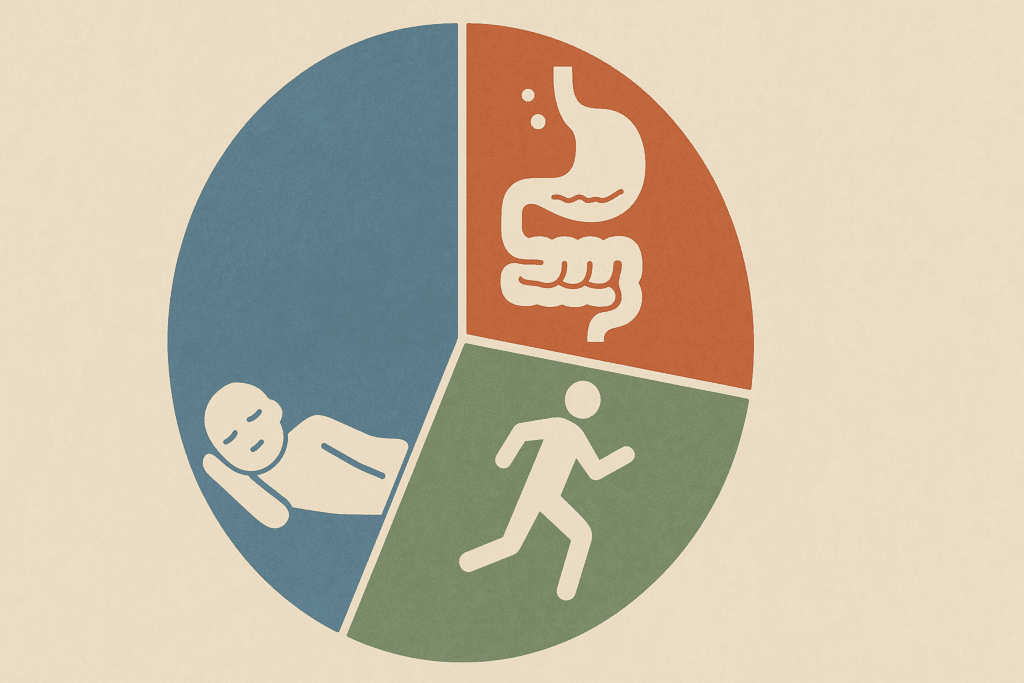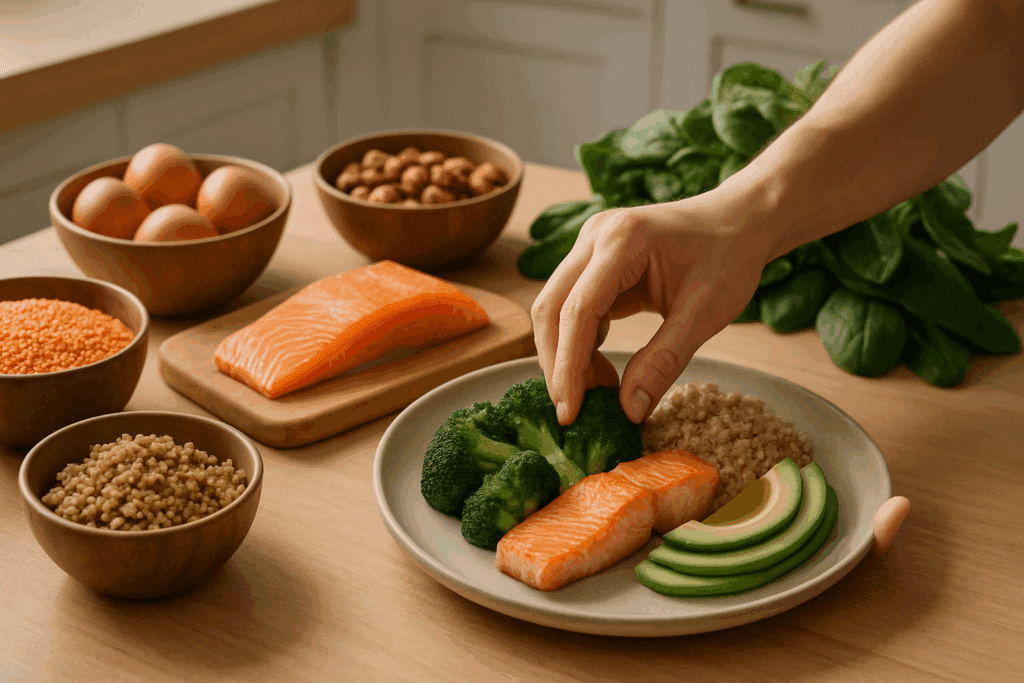Unlocking Your Metabolism: How to Burn More Calories Starts with Science
Understanding how to burn more calories is at the heart of effective weight management and long-term health. Yet for many, the idea of calorie burning is often reduced to hours on the treadmill or cutting out entire food groups. In reality, the science behind how to burn calories—especially safely and naturally—is far more nuanced and offers a wider range of sustainable options. Backed by the principles of metabolism, energy expenditure, and lifestyle medicine, modern experts now emphasize that the best way to burn calories is not necessarily about intensity, but consistency and personalization. Whether your goal is fat loss, fitness, or disease prevention, enhancing your body’s ability to burn energy efficiently can be achieved through targeted nutrition, intentional movement, and metabolic support.
You may also like: Expert-Backed Weight Loss Tips for a Healthier Lifestyle: What You Need to Know for Long-Term Weight Control and Wellness
Today’s conversation around how to burn calories fast has moved beyond crash diets and overly aggressive workouts. Instead, evidence-based strategies focus on how lifestyle habits can optimize basal metabolic rate (BMR), regulate hormones, and support mitochondrial function—the true engine of calorie burn. As we explore these strategies, we’ll also unpack common questions like “Does eating more calories burn more calories?” and “How can we burn calories in a way that’s both sustainable and scientifically sound?” From diet composition to physical activity, thermogenesis, and even sleep, this guide reveals how to burn calories easily, using real, medically grounded tools that empower long-term health.

Understanding How the Body Burns Calories: Beyond the Basics
To fully grasp the best way to burn calories, we must first understand how our body uses energy. Calories are units of energy derived from food, which our bodies convert to fuel vital functions—both voluntary (like exercise) and involuntary (like breathing or digestion). The total number of calories we burn each day is known as our Total Daily Energy Expenditure (TDEE), which consists of three primary components: basal metabolic rate (BMR), thermic effect of food (TEF), and physical activity.
BMR accounts for 60–75% of daily calories burned and represents the energy used for basic physiological functions at rest. This includes maintaining body temperature, brain activity, heart function, and cellular repair. Because BMR is the largest component of calorie burning, improving it is one of the most effective yet overlooked ways to burn more calories. TEF, or the energy used to digest and process food, represents about 10% of daily expenditure. It varies depending on food type—protein-rich foods, for example, require more energy to digest, offering a subtle but impactful metabolic edge.
Physical activity, including exercise and daily movement, makes up the remainder. It is the most modifiable part of our energy burn equation, offering the clearest path for those wondering how to burn calories fast or how to increase calorie output without drastic life changes. All three components work synergistically, and optimizing each is essential for a holistic and sustainable approach to burning more calories.

The Role of Nutrition in Burning More Calories Naturally
Nutrition plays a central role in how efficiently your body burns calories. While it may seem counterintuitive, eating more—specifically, eating more strategically—can actually increase your calorie expenditure. This leads to the commonly debated question: does eating more calories burn more calories? In certain contexts, the answer is yes. For instance, when individuals consume adequate calories, especially from high-protein sources, the thermic effect of food increases. Protein digestion uses more energy compared to fats or carbohydrates, and it supports muscle synthesis, which in turn elevates BMR.
In contrast, under-eating or extreme caloric restriction can lower metabolic rate as the body adapts to preserve energy. This phenomenon, known as adaptive thermogenesis, is one of the reasons why restrictive dieting often leads to weight loss plateaus. The body becomes more efficient at conserving energy, which, while biologically smart, makes sustained fat loss more difficult. In this light, one of the best ways to burn calories is to nourish the body adequately with whole, nutrient-dense foods that support metabolic function, rather than depriving it.
Furthermore, meal timing and frequency also influence calorie burning. Intermittent fasting, for example, has been shown to improve insulin sensitivity and mitochondrial efficiency in some individuals, potentially boosting fat oxidation. On the flip side, regular balanced meals with adequate protein can also support stable energy levels and maintain lean muscle mass—another critical factor in determining how to burn more calories throughout the day.

Physical Activity: The Fastest Way to Burn Calories in the Moment
When it comes to how to burn calories fast, nothing beats physical activity. But the conversation needs to shift from simply doing “more” to doing it smarter. High-Intensity Interval Training (HIIT) has emerged as one of the fastest ways to burn calories in a short time frame. By alternating between short bursts of high effort and periods of rest or lower intensity, HIIT workouts significantly elevate heart rate, oxygen consumption, and metabolic demand—sometimes leading to what’s called the “afterburn effect,” or excess post-exercise oxygen consumption (EPOC). This means your body continues to burn calories long after the workout ends.
However, not everyone benefits most from high-intensity exercise. For individuals new to fitness or managing chronic health conditions, moderate-intensity steady-state exercise, such as brisk walking, swimming, or cycling, can be just as effective when performed consistently. What matters most is choosing physical activity that is sustainable and enjoyable. After all, the best way to burn calories is the one you’ll stick with over the long haul.
Resistance training is another powerful yet often underestimated tool in the calorie-burning toolbox. Building muscle increases resting metabolic rate because muscle tissue requires more energy to maintain than fat tissue. This makes strength training one of the most strategic approaches to how to burn more calories, not just during exercise, but 24/7.

Non-Exercise Activity Thermogenesis (NEAT): How to Burn Calories Easily Throughout the Day
While scheduled exercise sessions are essential, they represent only a fraction of your day. This is where Non-Exercise Activity Thermogenesis (NEAT) comes into play. NEAT refers to the calories burned during everyday activities that are not classified as formal exercise—such as walking to the mailbox, fidgeting, cleaning, or even typing. Surprisingly, NEAT can account for hundreds of calories burned daily, and it’s often the hidden variable in how to burn calories easily without hitting the gym.
Research shows that individuals with high NEAT levels can burn up to 2,000 more calories per day than those with sedentary lifestyles, even if they engage in the same amount of structured exercise. This finding underscores the power of small, consistent choices. Taking the stairs instead of the elevator, standing while working, or walking during phone calls may seem minor, but they accumulate throughout the day, creating a significant calorie-burning effect.
If you’re wondering how can we burn calories in ways that feel effortless, NEAT provides a compelling answer. The key is to cultivate an active lifestyle mindset rather than relying solely on workouts. Over time, these small shifts compound into a profound impact on metabolism, weight management, and overall health.
The Hormonal Link: What Happens If You Start Burning Calories Too Fast?
Hormones play a vital role in regulating how we burn calories. Thyroid hormones, for example, are central to metabolic rate regulation, while insulin and cortisol also influence how efficiently we use energy. For individuals seeking the fastest way to burn calories, it’s crucial to understand that pushing the body too hard—whether through overtraining, sleep deprivation, or extreme dieting—can backfire by disrupting hormonal balance.
When stress levels rise, cortisol increases, which may lead to elevated blood sugar and fat storage, especially around the midsection. At the same time, leptin and ghrelin—hormones that regulate hunger and satiety—can be thrown off by chronic sleep loss or undernutrition, making it harder to maintain a healthy relationship with food. In this context, “What if you start burning calories too fast?” becomes a medically relevant concern. While short-term calorie deficits or intense workouts can support fat loss, long-term metabolic stress can impair the body’s ability to burn calories efficiently.
This is why expert-backed strategies focus on balancing the body rather than overwhelming it. Supporting hormones through adequate sleep, stress management, and proper nutrition ensures that your efforts to burn more calories are sustainable and safe. This comprehensive view distinguishes health-focused calorie burning from quick-fix fads, offering deeper and more reliable long-term results.

Hydration, Sleep, and Stress: Silent Drivers of Calorie Burn
While often overlooked, hydration, sleep, and stress levels quietly influence how many calories you burn each day. Water is essential for nearly every metabolic process, including lipolysis—the breakdown of fat. Even mild dehydration can impair cellular efficiency, reducing your ability to burn calories effectively. Drinking cold water may even offer a slight thermogenic effect, as the body expends energy to warm it to core temperature.
Sleep is equally vital. During restful sleep, the body undergoes hormonal and cellular repair that supports optimal metabolism. Chronic sleep deprivation has been linked to increased insulin resistance, reduced leptin levels, and elevated ghrelin—creating the perfect storm for weight gain and reduced calorie burning. Prioritizing 7–9 hours of quality sleep may not seem like a traditional strategy for how to burn more calories, but science shows it’s one of the most effective metabolic enhancers.
Stress, too, plays a disruptive role. Persistent psychological stress activates the sympathetic nervous system and elevates cortisol, which not only promotes fat storage but can also dampen motivation to engage in physical activity or make healthy food choices. Incorporating mindfulness, nature walks, or relaxation practices into your day can significantly enhance your ability to burn calories naturally by restoring the body’s hormonal equilibrium.

The Power of Muscle: Why Strength Is the Metabolic Secret Weapon
Muscle is often referred to as “metabolic currency” because of its high energy demands. For those serious about finding the best way to burn calories, developing and maintaining lean muscle mass is non-negotiable. Skeletal muscle accounts for the majority of glucose disposal in the body, meaning it helps regulate blood sugar and insulin sensitivity—both of which affect how efficiently we burn and store calories.
Moreover, muscle tissue is metabolically active even at rest, unlike fat tissue. This means that increasing muscle mass through resistance training naturally raises your BMR, leading to a higher TDEE without additional effort. For those asking how can we burn calories consistently over time, building strength is one of the most effective answers. From a preventive health perspective, it also reduces risk for age-related muscle loss (sarcopenia), metabolic syndrome, and type 2 diabetes.
Strength training doesn’t require heavy weights or complex gym machines. Bodyweight exercises, resistance bands, or even yoga can stimulate muscle growth and support metabolic resilience. What’s critical is progressive overload—the gradual increase in resistance or intensity over time. This progressive approach ensures continued gains and avoids the metabolic plateaus that often accompany static workout routines.
Sustainable Strategies: What Experts Recommend for Long-Term Success
Expert consensus now favors sustainability over speed when it comes to metabolic health. While many want to know the fastest way to burn calories, what’s more important is identifying strategies you can maintain over the long term. Crash diets, detoxes, or overexercising may offer short bursts of calorie burn, but they often disrupt hormonal balance, degrade lean tissue, and cause psychological burnout.
Instead, experts recommend an integrated approach that combines whole-food nutrition, varied physical activity, muscle-building, and restorative lifestyle habits. Tracking your progress through non-scale metrics—like energy levels, strength gains, or improved sleep quality—offers a more holistic view of success than simply watching the scale. In fact, metabolic health is a better predictor of longevity than weight alone.
It’s also essential to individualize your approach. Factors like age, gender, genetics, and underlying medical conditions all influence how to burn calories most effectively. What works for one person may not work for another, which is why flexibility, curiosity, and support from qualified health professionals are key components of long-term success.
Frequently Asked Questions (FAQ): Expert Insights on the Best Way to Burn Calories Safely and Naturally
1. Can mindset and motivation impact how to burn more calories effectively?
Absolutely. While often overlooked, psychological factors such as motivation, self-efficacy, and mindset can significantly influence how to burn more calories consistently. Individuals who set achievable goals and develop intrinsic motivation—such as exercising for energy or longevity rather than just appearance—tend to adhere to healthy behaviors more reliably. This adherence directly contributes to greater overall calorie expenditure over time. Cognitive-behavioral strategies, including positive self-talk and visualization, can reinforce habits that promote how to burn calories fast in ways that are sustainable and personalized. When motivation is tied to a deeper purpose or lifestyle value, the best way to burn calories shifts from being a chore to a long-term wellness practice.
2. Is it possible to use wearable technology to identify the fastest way to burn calories?
Yes, wearable fitness trackers and smartwatches offer valuable real-time insights that can help optimize how to burn calories with precision. These devices estimate metrics such as heart rate, active minutes, and energy expenditure, providing personalized feedback. For instance, seeing how your heart rate responds to different workouts can reveal which exercises align with your personal fastest way to burn calories. Additionally, some devices track trends in resting metabolic rate, helping users understand long-term changes in how to burn more calories. The key is not just collecting data, but interpreting it intelligently to adjust behavior and maximize metabolic output efficiently.
3. How does age affect how to burn calories, and what can older adults do to counteract metabolic slowdowns?
As we age, metabolic rate naturally declines, largely due to muscle loss and hormonal shifts. This can make the question of how to burn calories more efficiently even more relevant for older adults. Fortunately, resistance training becomes increasingly important as it helps preserve lean muscle mass, which directly supports calorie burning. Including activities like tai chi, Pilates, or light weightlifting can significantly boost how to burn calories easily for this population. Furthermore, focusing on high-quality protein intake and prioritizing sleep helps older adults support metabolic function and counter age-related energy slowdowns. Aging doesn’t mean you lose the ability to burn calories; it just requires a more intentional approach rooted in strength, recovery, and nutrition.
4. Does eating more calories burn more calories in athletes and highly active individuals?
In physically active populations—especially athletes—the question “does eating more calories burn more calories” takes on a practical and biological dimension. When activity levels are high, increasing caloric intake appropriately can prevent the body from entering a catabolic state, where muscle is broken down for energy. In fact, under-fueling can lead to performance decline and reduced metabolic efficiency. For athletes, strategic calorie consumption not only replenishes energy stores but supports muscle recovery and thermogenesis, allowing for higher daily energy output. In this case, eating more doesn’t just replenish—it fuels greater energy burn, exemplifying how to burn more calories by matching energy input to output demands.
5. What role do cold exposure and environmental factors play in how to burn calories fast?
Environmental stressors like cold exposure activate a type of fat called brown adipose tissue (BAT), which burns energy to produce heat—a process known as non-shivering thermogenesis. This physiological response offers a novel perspective on how to burn calories fast without exercise. Even short periods in cooler environments, such as cold showers or outdoor winter walks, can modestly boost calorie expenditure. While it’s not the fastest way to burn calories in terms of volume, it adds another layer to a well-rounded strategy. When combined with other metabolic activators like movement and nutrition, environmental stimuli can contribute meaningfully to how we burn calories across different settings.
6. How can social support influence how to burn more calories long-term?
Social dynamics profoundly shape behavior, including how to burn more calories consistently over time. Studies show that people are more likely to succeed with weight loss and fitness goals when supported by peers or community groups. Shared accountability, friendly competition, and emotional encouragement can increase motivation and adherence to physical activity. For example, group fitness classes, walking clubs, or even social media challenges can help individuals stay engaged in how to burn calories easily without losing momentum. This social reinforcement transforms calorie burning from an isolated effort into a shared lifestyle, which research indicates is far more sustainable.
7. Are there specific foods or ingredients that offer a thermogenic advantage for how to burn calories?
Yes, certain foods exhibit thermogenic properties, meaning they increase heat production and calorie expenditure during digestion. Capsaicin, found in chili peppers, is one such compound known to slightly enhance how to burn calories through thermogenesis. Similarly, green tea contains catechins and caffeine, which may increase fat oxidation. While these foods are not magic bullets, when incorporated into a nutrient-rich diet, they can amplify how to burn calories fast in a natural way. It’s important to view them as metabolic boosters within a broader strategy, rather than relying on them as standalone solutions for fat loss.
8. What if you start burning calories too quickly—can that be harmful?
Rapid, unsustainable calorie burning—especially from extreme dieting or overtraining—can lead to metabolic stress, hormonal imbalance, and muscle loss. So, what if you start burning calories at a rate that outpaces nutritional intake? In that case, the body may shift into a catabolic state, breaking down lean tissue for energy and slowing metabolism to protect vital functions. This can result in fatigue, weakened immunity, and long-term metabolic damage. The best way to burn calories is to ensure that output is supported by adequate nutrition, recovery, and hydration. Going too fast for too long often backfires, reinforcing the need for gradual, evidence-based approaches to energy balance.
9. How can we burn calories efficiently during sedentary workdays or long office hours?
Modern lifestyles often limit movement, but even within sedentary environments, there are ways to learn how to burn calories effectively. Desk-based NEAT strategies—such as standing desks, short walking breaks, or leg fidgeting—can add up to meaningful energy expenditure. Light resistance bands under the desk, stretch routines between meetings, or setting movement reminders on smart devices help maintain physical activity levels without disrupting productivity. Learning how to burn calories easily throughout sedentary hours requires creativity and intentionality, but the cumulative effect over time can rival more structured workouts in terms of total calorie burn.
10. What’s the relationship between creativity and how we burn calories?
Though not often discussed, cognitive activity—especially creative thinking and problem-solving—does contribute to calorie burn, albeit modestly. The brain is an energy-intensive organ, using about 20% of the body’s daily calories. During intense mental work, glucose uptake in the brain increases, subtly shifting metabolic demand. While this isn’t the fastest way to burn calories in a traditional sense, it adds an intriguing dimension to how to burn more calories holistically. Incorporating intellectually stimulating activities alongside physical ones reflects a more complete understanding of human energy expenditure—and reminds us that every system in the body plays a role in the broader metabolic landscape.
Final Thoughts: Best Way to Burn Calories Backed by Experts—A Natural, Sustainable Path to Better Health
Understanding the best way to burn calories isn’t about chasing quick fixes or punishing your body into submission. It’s about working with your body’s natural rhythms and physiological needs to unlock greater health, energy, and resilience. By focusing on how to burn more calories through balanced nutrition, smart physical activity, and sustainable lifestyle habits, you can elevate your metabolic potential without risking hormonal disruption or burnout.
Whether you’re seeking how to burn calories fast during a workout, exploring how to burn calories easily through daily movement, or simply wondering, “What if you start burning calories more efficiently over time?” the answer lies in consistency, personalization, and evidence-based choices. Experts agree that a healthy metabolism thrives not on extremes, but on nourishment, movement, rest, and care.
With this approach, the question isn’t just how can we burn calories—it’s how can we do so in a way that supports total well-being. The answer, as science and experience both affirm, is that safe, natural calorie burning is a byproduct of a life lived in alignment with your body’s deepest needs. And that, ultimately, is the most powerful strategy of all.
Further Reading:
Burning calories without exercise


